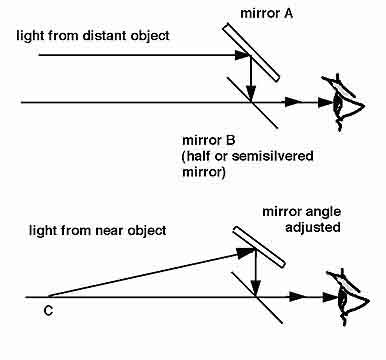|
... on the topic of rangefinders ...
One of the tasks of a photographer is to make sure that the lens of the camera is focused on the subject of interest. One method of doing this is to estimate the distance to the subject and then set the lens to a position that has been predetermined by the manufacturer as being the appropriate position for the lens to bring that particular subject distance to a focus on the surface oif the photosensitive material be it film or a solid state sensor. Another way to do this is to focus the image on a groundglass that is later replaced by the film. This is widely used in "view cameras". The same system can also be used but the image is focused on a groundglass that is located at the same distance from the lens as the plane of the photosensitive material. This is done by placing a moveable or semitransparent mirror in the light path angled at 45 degrees to the optical axis. When the image is focused on the groundglass it ensures that the image will also be sharply focused on the film. This is the system used in all Single Lens Reflex cameras. In "rangefinder" cameras a rangefinder, instead of human judgement, is used to determine the distance to an object and the location of the lens from the film plane is simultaneously or subsequently adjusted to the correct location so that the subject's image is properly focused on the film during exposure. Rangefinders come in many different styles and operate on several different principles. The most basic kind of rangefinder functions as follows: One of two rays of light from a distant subject is reflected at right angles on mirror A and then onto a second (semi silvered) mirror B, which then reflects it to the eye. The other ray passes directly through the semi-silvered mirror (B) to the eye. Thus, although there are two images of that particular point of the subject (and indeed two images of the subject itself) they are superimposed and appear as one.  The greater the precision with which the magnitude of angle A can be determined the more accurate the rangefinder. Since the angle increases as the distance to the subject becomes less, a rangefinder is more accurate for short distances than for long. Accuracy of the rangefinder also depends on the distance between mirrors A and B, referred to as the BASE of the rangefinder. Military rangefinders often have bases of a few feet. Astronomers sometimes use the motion of the Earth in space as a method of establishing truly long baselines for measurement of interstellar distances (although even this method of achieving a long baseline is often inadequate for intergalactic distance measurements). The relationship between Baseline, object distance and Angle of mirror is: Baseline divided by tangent of 2 times Mirror angle = Distance to object C So, when the angle of the main reflecting mirror is 45 degrees to the light rays proceeding through the semisilvered mirror the object distance is infinite. When the main mirror is at 22.5 degrees then the object distance is equal to the baseline. To measure large distances the angle through which the main mirror needs to be turned is very small indeed. Rangefinders are usually connected, or coupled, with the lens so that one does not use the rangefinder to determine a distance and then transfer that distance reading to a scale on a lens mount (although this was done regularly in the past) to focus the lens on a subject at that given distance, but rather the rotation of the lens in its mount or movement of the lens in a track, causes mirror A to rotate. Thus when the two images seen in the rangefinder appear superimposed, the lens is automatically focused on that distance. Coupling is usually accomplished by a lever; one end of the lever is held by a spring against the rear of the lens mount, and the other controls the rotation of the mirror (or a prism) in the rangefinder. A couple of the most famous coupled rangefinder cameras ever made are the Leica and the Contax. It was the 35mm Contax camera by Zeiss Ikon that in 1931 introduced the concept of coupled rangefinder and interchangeable lenses available on the same camera body. There are other methods for determining whether an image is sharply socused on the desired image plane but the rangefinder method described above is the fundamental one. from a "collaboration" between ADavidhazy (extemporaneous comments) and CB Neblette (Dean Emeritus of the College of Graphic Arts and Photography at RIT (now deceased)) from his book: Fundamentals of Photography, Van Nostrand Reinhold, 1970. |